Question 1
LEVEL 6
Find the region, R, of the graph that satisfies the inequality y\leq2x+3.
Select the correct answer from the list below:
A:
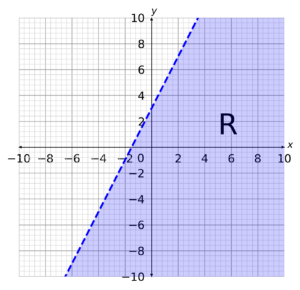
B:
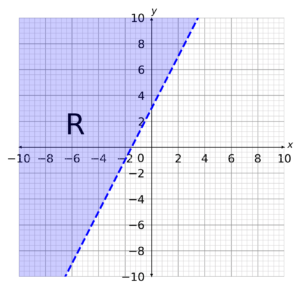
C:

D:
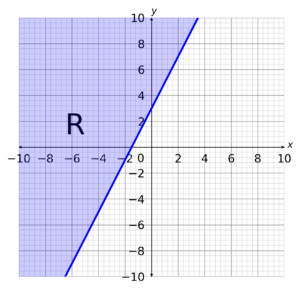
CORRECT ANSWER: C
WORKED SOLUTION:
Start by thinking of y\leq2x+3 as an equation instead, y=2x+3. We know how to draw this.
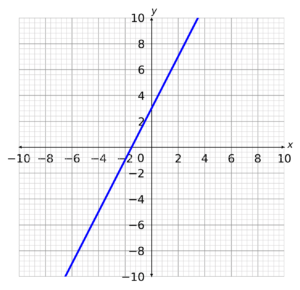
And now, because it is \leq, we just need to shade the region beneath the graph and label it R. (We also need to remember that because it has “equals” it is a solid line).

To check you have the right region, you can choose a point and put those values of x and y into the inequality.
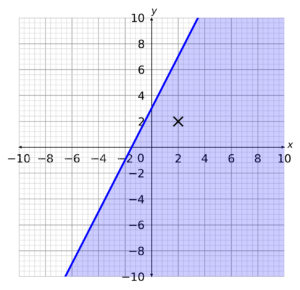
Try (2,2)
x=2 \textrm{ and } y=2
y\leq2x+3
2\leq2\times2+3
2\leq4+3
2\leq7
Which is true, so we have the correct region.
Question 2
LEVEL 6
Which inequality is described by the shaded region below?
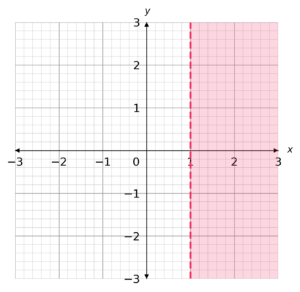
Select the correct answer from the list below:
A: x>1
B: x<1
C: y<1
D: x\leq1
CORRECT ANSWER:A: x>1
WORKED SOLUTION:
The line is dashed, so we know that the answer must have a strict inequality, < or >.
The equation of the line is x = 1, since is cuts through the x-axis at 1, so the answer must be x>1 or x<1.
The shaded area is to the right of the line, that includes x values greater than 1.
So the answer must be x>1.
Question 3
LEVEL 6
Which inequality is described by the shaded region below?
Select the correct answer from the list below:
A: x>1
B: x\geq1
C: y<1
D: x\leq1
CORRECT ANSWER: B: x\geq1
WORKED SOLUTION:
The line is solid, so we know that the answer must have an inclusive inequality, \leq or \geq.
The equation of the line is x = 1, since is cuts through the x-axis at 1, so the answer must be x \geq 1 or x \leq 1.
The shaded area is to the right of the line, that includes x values greater than or equal to 1.
So the answer must be x \geq 1.
Question 4
LEVEL 6
Which inequality is described by the shaded region below?

Select the correct answer from the list below:
A: y>3
B: y\leq3
C: y\geq3
D: y>3
CORRECT ANSWER: C: y\geq3
WORKED SOLUTION:
The line is solid, so we know that the answer must have an inclusive inequality, \leq or \geq.
The equation of the line is y = 3, since is cuts through the y-axis at 3, so the answer must be y \geq 3 or y \leq 3.
The shaded area is above the line, that includes y values greater than or equal to 3.
So the answer must be y\geq3.
Question 5
LEVEL 6
Which inequality is described by the shaded region below?
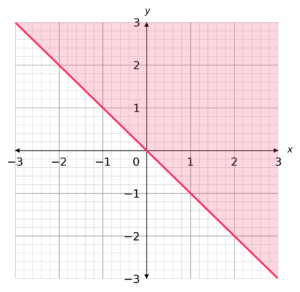
Select the correct answer from the list below:
A: x+y>0
B: x+y\geq0
C: x-y\geq0
D: x+y\leq0
CORRECT ANSWER:B: x+y\geq0
WORKED SOLUTION:
The line is solid, so we know that the answer must have an inclusive inequality, \leq or \geq.
The equation of the line is y = - x which is equivalent to y + x = 0, so the answer must be B,C or D..
The shaded area is above the line, that includes values of x + y greater than or equal to 0.
So the answer must be x+y\geq0.
Question 6
LEVEL 6
Which set of inequalities is described by the shaded region below?
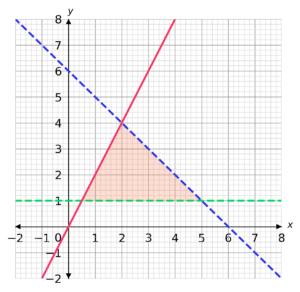
Select the correct answer from the list below:
A: y - 2x \geq 0, \,\, y >1, \,\, y + x - 6 > 0
B: y - 2x \leq 0, \,\, y >1, \,\, y + x - 6 < 0
C: y - 2x <0, \,\, y \geq 1, \,\, y + x - 6 \leq 0
D: y - 2x \leq 0, \,\, x >1, \,\, y + x - 6 < 0
CORRECT ANSWER: B: y - 2x \leq 0, \,\, y >1, \,\, y + x - 6 < 0
WORKED SOLUTION:
The equation of the red line is y = 2x which is equivalent to y-2x=0.
The line is solid, so we must have an inclusive inequality, \leq or \geq.
The shaded area is below the line, that includes the values of y-2x less than or equal to 0.
So we have y - 2x \leq 0.
The equation of the blue line is y = - x + 6 which is equivalent to y+x - 6=0.
The line is dashed, so we must have a strict inequality, < or >.
The shaded area is below the line, that includes the values of y+x-6 less than 0.
So we have y + x - 6 < 0.
The equation of the green line is y = 1.
The line is dashed, so we must have a strict inequality, < or >.
The shaded area is above the line, that includes the values of y greater than 1.
So we have y > 1.
So our answer is B.
Question 7
LEVEL 6
Find the shaded region for the following inequalities:
x \geq 1y \leq 5
y-x+1 >0
Select the correct answer from the list below:
A:
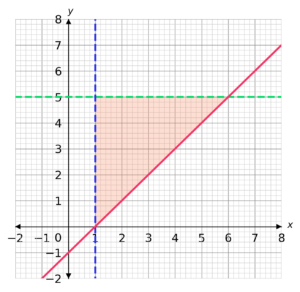
B:
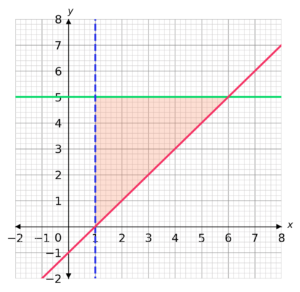
C:

D:

CORRECT ANSWER: D
WORKED SOLUTION:
x=1 is a vertical line passing through 1 on the x axis.
Since we want x \geq 1, we want a solid line and the shaded area will be to the right of the line, where the values of x are greater than or equal to 1.
y=5 is a horizontal line passing through 5 on the y axis.
Since we want y \leq 5, we want a solid line and the shaded area will be below the line, where the values of y are less than or equal to 5.
y-x+1=0 is equivalent toy = x - 1, which is a line passing through -1 on the y axis, with a gradient of 1.
Since we want y-x+1 >0 we want a dashed line and the shaded area will be above the line, where the values of y-x+1 are greater than or equal to 0.
Therefore our answer is D.
